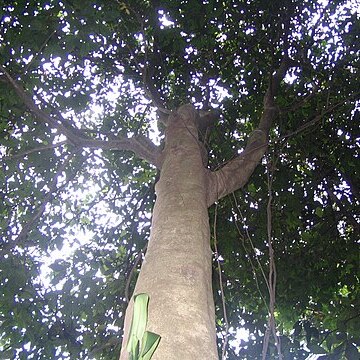Small tree, rarely to 20 m high, 25 cm in diameter. Branchlets terete, red, glossy, drying reddish to light brown when dry, scaly, rusty puberulous, glabrescent. Leaves: petiole 0.5-4(-6) cm, gla-brous(-puberulous), gland orbicular, sessile, semi-globose, flat, or depressed; pinnae 1 pair, 2-10 cm, glabrous (-puberulous); petiolule 2-5 mm, glabrous; leaflets 1 or 2 pairs per pinna, opposite, chartaceous-coriaceous, drying grey-green, ± unequal-sided, elliptic, ovate-elliptic, or lanceolate, 5.5-16(-22) by 2.5-10.5 cm, base ± symmetrically cuneate, somewhat tapering in the distal pair of leaflets, apex obtusely acuminate, glabrous at both surfaces; principal lateral veins c. 7 per leaflet-half, strongly arching, non parallel; reticulation delicate, dense, prominulous on both surfaces. Inflorescences terminal or axillary at the distal leaves, rusty tomentose-puberulous, ± glabrescent, consisting of pedunculate glomerules aggregated into panicles to 20 cm long; glomerules composed of c. 5 sessile or subsessile flowers; floral bracts triangular, acute, less than 1 mm, tomentose. Flowers pentamerous, white, sweetly scented. Calyx campanulate or broadly cup-shaped, 1.5-2.5 mm, rusty short-tomentose or puberulous; teeth (broadly) triangular, to 0.5 mm. Corolla funnel-shaped, puberulous, 2.5-5 mm; lobes triangular-ovate to elliptic, often recurved, 1-c. 2 mm. Stamens c. 9 mm, the tube equalling the corolla-tube. Ovary solitary, glabrous. Pod green or red, becoming yellowish outside, reddish inside, cylindrical to compressed, straight or ± curved, turgid, 3-5-10 by 1.5-2.5 cm, woody, densely puberulous or subglabrous, veins inconspicuous, dehiscing along both sutures. Seeds black, filling the entire cavity of the pod, the central ones irregularly disc-like, 8-15 mm high, terminal ones turbinate-truncate.
More
A small tree. Occasionally it can grow to 20 m high. The trunk is 25 cm across. The bark is smooth or with tiny cracks. The small branches are rounded, red and glossy. The leaf stalk is 0.5-4 cm long. The leaves are twice divided. The first leaflets are one pair 2-10 cm long and these have one or two pairs of second leaflets 5.5-16 cm long by 3-10 cm wide. The flower cluster is at the end of the branch or in the axils of leaves towards the ends of the branches. These are made up of about 5 flowers clustered closely together in a head and these are white and have a sweet smell. The fruit is a pod which can be green or red but ripens to yellow outside and reddish inside. The pods are 3.5-10 cm long by 1.5-2.5 cm wide and can be straight or curved. They are stiff and woody. They split open along both sides. The seeds are black and fill the entire cavity of the pod. The seeds in the centre are like a disk while those near the end are like a top.

